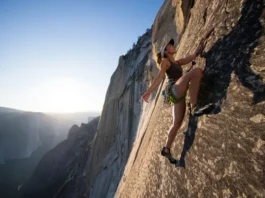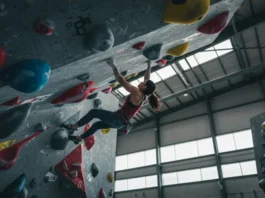In this article
Traditional climbing, at its heart, is an adventurous pursuit that captivates dedicated climbers. It’s a discipline where climbers place their own protective gear—a core concept of this type of climbing that opens up a world of unique challenges and rewards. This article will explore the skills, mindset, and ethics that define trad climbing, looking beyond the mere mechanics of climbing gear to reveal a holistic practice of self-reliance for every climber. We’ll touch upon how it differs from other styles, like sport climbing, preparing you for a deeper dive.
Defining the Craft: What is Trad Climbing Fundamentally?
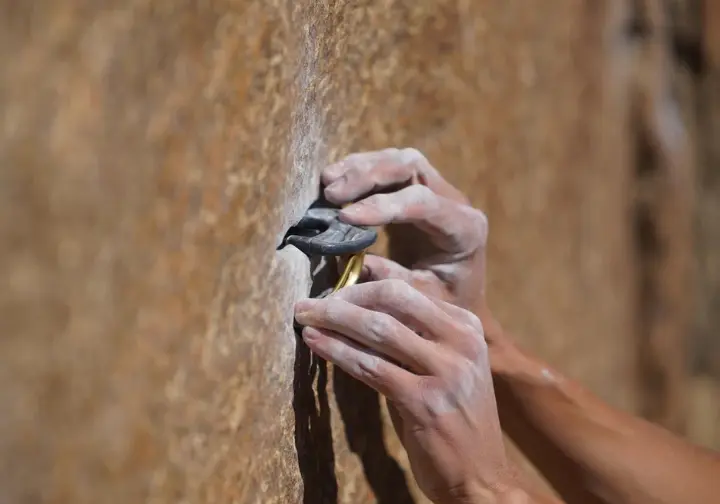
To truly grasp trad climbing, we must establish a clear, foundational understanding of this style. It’s important to see how it contrasts with other climbing approaches, particularly highlighting the central role of removable climbing protection. This section directly addresses the question: what is trad climbing?
The Essence of Trad Climbing: Placing Your Own Path
Traditional (trad) climbing is a style of rock climbing where the lead climber places all protective gear into natural features of the rock as they ascend. This climbing equipment, often called “protection” or “pro,” serves as temporary climbing protection and is then removed by the second climber, ideally leaving no trace on their ascent. This practice of defining traditional climbing contrasts sharply with sport climbing, where climbing bolts are pre-installed. The core principle revolves around self-sufficiency; the climber creates their safety system using traditional climbing techniques. This involves selecting appropriate gear for the rock, placing it securely, and understanding its limits. The philosophy emphasizes adventure, problem-solving, and is a form of climbing where you place your own pro.
This method is the original form of rock climbing and how climbing was always done until fairly recently, predating bolted sport routes. It requires a broad skillset, including technical knowledge of gear, rock assessment, and risk management, alongside physical ability. Many climbers begin by learning about essential beginner climbing gear to understand the basics of traditional climbing protection. The community, with organizations like the American Alpine Club playing a significant role in American climbing, often provides resources and standards; for instance, the American Alpine Club’s role in promoting safe and ethical climbing is widely recognized.
Trad vs. Sport Climbing: Key Distinctions
The most significant difference in trad versus sport lies in protection: trad climbers place removable gear, while sport climbers clip into pre-placed, permanent climbing bolts. This impacts risk, skills required, and the overall climbing experience. Sport climbing often allows a sport climber to focus purely on physical movement. Trad climbing integrates technical gear skills and constant risk assessment. For a clear overview, some find resources explaining traditional climbing basics explained very helpful, especially when comparing it to a pre-bolted sport-climb.
Trad climbing generally involves greater perceived and actual risk, as protection security depends on the leader’s skill. Sport climbing routes are often more predictable. Trad routes require the leader to find placements, which may be sparse. The gear also differs; a trad climber carries a “rack” of cams, nuts, and slings. A sport climber primarily needs quickdraws used in sport climbing. Many sources outline sport versus trad climbing differences for those seeking more detail on these distinct types of sport climbs and traditional climbs.
Historical Roots of Trad Climbing
Trad climbing is the original style, evolving from early mountaineering practices where first rock climbers protected rock sections of alpine ascents. Early climbing protection involved rudimentary techniques, often relying on natural features like wedged rocks or slings around rock horns. This historical context, often detailed when exploring the history of rock climbing, underscores its adventurous nature. It truly marks the birth of trad climbing as a distinct pursuit, long before competition climbing became widespread.
The development of specialized climbing equipment, like pitons in the early 20th century by pioneering 20th-century rock climbers, allowed climbers to tackle more difficult and steeper rock faces. However, hammering pitons damaged the rock, leading to an ethical shift within the climbing community. This evolution paved the way for “clean climbing,” emphasizing removable protection and influencing styles like free climbing. Understanding this history provides insight into the values central to modern trad climbing, influencing the legacy of El Capitan routes and other iconic traditional climbing routes.
The Trad Climber’s Rack: Understanding Essential Gear

The specialized climbing equipment, the “rack,” is what trad climbers rely on. This collection of trad gear includes passive and active protection, alongside other critical items. Understanding each component’s function and application is fundamental to the practice of trad rock climbing.
Passive Protection: Nuts, Hexes, and Slings
Passive protection consists of pieces of gear that have no moving parts and work by lodging securely into rock constrictions, such as cracks or pockets. Common types are nuts (stoppers or chocks) and hexes. Nuts are tapered metal wedges; hexes are larger, often for wider cracks. A comprehensive trad climbing gear checklist will always feature these items.
Effective placement relies on finding features where gear wedges securely against a downward or outward pull in the event of a fall. Climbers assess rock quality and ensure maximum surface contact. Slings (runners) of nylon or Dyneema extend placements, reduce rope drag, or sling natural features like rock horns or trees. They are indispensable when building a rack with protection (cams, nuts).
Active Protection: Cams and Their Mechanics
Active protection, most notably spring-loaded camming devices (SLCDs or “cams”), have moving parts that expand to grip the sides of a crack. Cams suit parallel-sided or slightly flaring cracks where passive protection might not be as effective. They have multiple lobes on an axle, retracting when a trigger is pulled and expanding on release.
A cam converts a downward pull into an outward force against the rock, creating a secure placement. Proper cam placement involves correct sizing, ensuring all lobes are engaged with the rock, and orienting the cam in the direction of potential pull. Cams protect cracks from finger-width to offwidth dimensions, crucial for many types of crack climbing. They are complex and pricier than passive pro, requiring judgment on rock quality and placement security. Understanding UIAA safety standards for climbing equipment for such frictional anchors is important, as is selecting lockable climbing carabiners to connect them.
Personal Gear: Harness, Helmet, Shoes, and Rope
Beyond protection pieces, personal climbing gear is critical for safety and performance in trad climbing. A comfortable and well-fitting harness designed for trad, often with more gear loops like some trad harnesses like the Petzl Adjama, is essential for carrying the rack and for comfort during long climbs and at belays. A climbing helmet is non-negotiable in trad climbing due to risks of falling debris or head impact. When selecting the best rock climbing helmet, prioritize fit and protection. Appropriate trad climbing shoes like La Sportiva TC Pro aid performance.
The climbing rope is the lifeline. Dynamic ropes absorb fall energy. Depending on the route, climbers might use a single rope, half ropes, or twin ropes, each with specific advantages for rope management and safety on the ascent. Familiarizing oneself with how to build a trad rack often starts with understanding these personal gear choices.
Mastering the Craft: Essential Trad Climbing Skills

This area focuses on fundamental practical skills for trad climbing, from placing gear effectively to building secure anchors and navigating climbing routes. These abilities are foundational to safe and enjoyable trad climbing.
Core Skills: Gear Placement Techniques
Proficient gear placement is the cornerstone of safe trad climbing. It involves assessing rock quality, choosing the right protection, and ensuring the placement is multi-directional and solid. A good placement inspires confidence. Climbers learn to “read” the rock for constrictions, parallel cracks, and pods suitable for nuts, hexes, or cams. They consider the direction of potential pull.
Practicing placements, initially at ground level, is crucial for developing proficiency, efficiency, and strength. Understanding how gear works and its limitations in various rock types is vital. These skills are fundamental when learning how to start trad climbing. Good gear placement is complemented by mastering movement and footwork.
Core Skills: Anchor Building Fundamentals
Building strong, reliable anchors is critical for belaying, securing oneself, or rappelling. Trad anchors are typically constructed using multiple protection pieces equalized to distribute the load. Belaying is a critical safety technique, and solid anchors are its foundation, whether for single-pitch rock climbing or longer climbs.
Key principles are often summarized by acronyms like SERENE or ERNEST. Each piece should be bomber, load shared, backups used, system built efficiently, and designed so failure of one piece doesn’t shock-load others. Climbers use slings, cordelettes, and the climbing rope to connect pieces to a master point. Learning this skill, sometimes involving an abseil rope for descents, is part of leading and following in trad climbing.
Principles of a Solid Anchor (SERENE/ERNEST)
Acronyms like SERENE (Solid, Equalized, Redundant, Efficient, No Extension) offer a checklist for reliable trad anchors. ‘Solid’ means each piece is bomber in good rock. ‘Equalized’ means load is distributed evenly. Many resources explain trad anchor principles SERENE in detail.
‘Redundant’ implies multiple points; if one fails, others hold. ‘Efficient’ means timely construction without excessive gear. ‘No Extension’ ensures if one piece fails, the system doesn’t suddenly extend, shock-loading remaining pieces. Applying these principles is crucial. While advanced, understanding how Pulleys are essential tools for climbers can relate to complex anchor setups, including those used in aid climbing.
The Art of Route Finding on Natural Terrain
Unlike sport climbs that follow bolts, trad routes often require significant route-finding skills. The leader interprets natural features of the rock to find a viable path upwards that offers opportunities for climbing protection and aligns with the route description or topo for that specific terrain. This involves looking ahead, identifying crack systems and weaknesses. Learning about reading routes and using guidebooks is a good starting point for any climber.
Guidebooks provide info, but on-the-wall interpretation is key. Lichen, loose rock, or vegetation can obscure the line. Misreading can lead to harder climbing or poor protection. Developing route-finding intuition takes experience, like when navigating Red River Gorge routes, and is a core part of the trad climbing adventure along any chosen course.
Beyond the Mechanics: The Mental Game, Adventure, and Self-Reliance
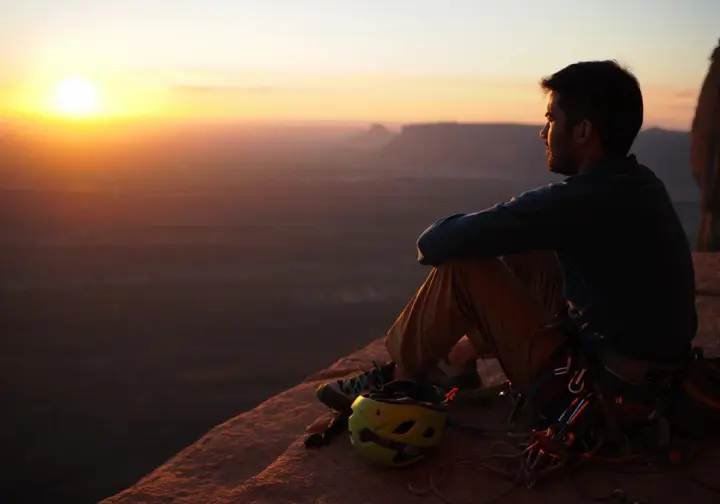
Trad climbing extends far beyond physical technique and placing protection. It deeply engages the mind, calls to our sense of adventure, and fosters profound self-reliance. These aspects are often what truly define the trad experience.
The Mental Game in Trad: What is Trad Climbing Psychology?
The mental game, or “head game,” is as important as physical skill in trad climbing. It involves managing fear, maintaining focus under pressure, making clear decisions, and cultivating resilience. A strong mental game allows optimal performance in challenging situations. The psychology of rock climbing is a field that explores these aspects for every climber.
Trad climbing involves higher uncertainty than sport climbing, demanding greater psychological fortitude from the traditional climber. Consequences of mistakes can be severe, requiring a calm, analytical approach. Developing mental strategies like visualization and positive self-talk enhances a trad climber’s performance and enjoyment. Considering the benefits of unplanned breaks during climbing can be part of this mental management.
The Adventure Element: Exploration and the Unknown
Trad climbing is often synonymous with “adventure climbing” due to its elements of exploration and uncertainty. Unlike following bolts, trad climbers may venture onto less-traveled routes or even establish new lines on a trad project, relying on their skills. This sense of adventure comes from route finding, commitment on long climbs, and self-reliance.
The environments where trad climbing takes place—a remote climbing area with towering cliffs, mountain trad crags, sea cliffs—often contribute to the feeling of adventure, offering a profound connection with nature even for a new climber. These experiences can be deeply rewarding. Many AAC member climbing stories capture this spirit. The adventure of climbing Devils Tower is a classic example of such an experience.
Cultivating Self-Reliance and Problem-Solving
Trad climbing is an exercise in self-reliance. From choosing routes to placing protection and building anchors, the climber is responsible for safety and progress. This fosters capability and independence. Problem-solving is constant: a complex gear placement, a tricky sequence of movement, or unexpected challenges like a stuck rope.
The ability to remain calm, think clearly, and find creative solutions is crucial. This cycle of assessment, decision-making, and execution builds technical skills, judgment, and resourcefulness. Effective risk management in climbing is a learned skill. This self-reliance also involves knowing personal limits in climbing.
The Ethical Compass: Clean Climbing and Environmental Stewardship
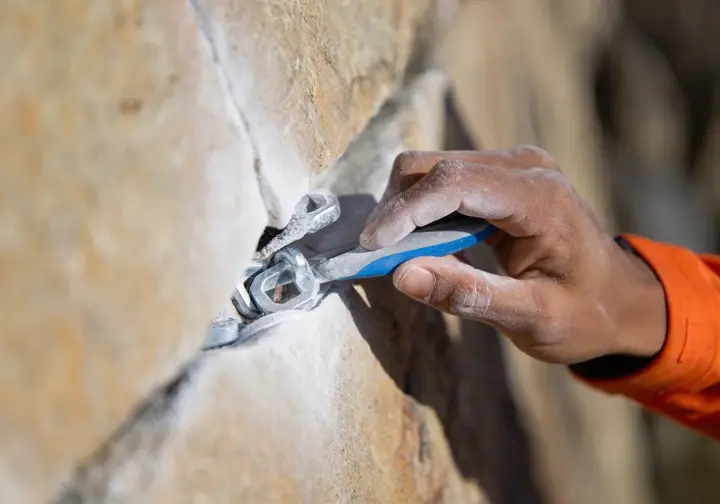
Trad climbing possesses strong ethical foundations. The principles of “clean climbing,” adherence to Leave No Trace, and the climber’s active role in preserving the natural environment are central to its practice.
The Ethos of Clean Climbing: A Deeper Look
“Clean climbing” is a core ethic in trad climbing emphasizing ascent while minimizing physical environmental impact. This means using removable protection (nuts, cams) instead of climbing gear that damages the rock, such as pitons. The goal is to leave rock pristine. This philosophy gained prominence during the “Clean Climbing Revolution.”
Beyond gear, clean climbing includes broader respect for the rock environment: avoiding altering features, minimizing chalk, and treading lightly. It’s a mindful interaction. Organizations like the Access Fund’s role in climbing advocacy is vital. Such clean climbing practices in Zion are often mandated.
The Clean Climbing Revolution and Its Pioneers
The Clean Climbing Revolution (1960s-1970s) marked a pivotal shift in climbing ethics. Visionary climbers, true Yosemite climber pioneers like Yvon Chouinard, Royal Robbins, and Tom Frost championed techniques minimizing rock damage, especially in Yosemite. They advocated for a new ethic and developed removable protection.
Their efforts showed challenging climbs could be ascended without permanent scarring. This movement was a philosophical stand for environmental responsibility and preserving climbing’s natural challenge. Examining Yosemite climbing ethics and safety provides context. The Praying Monk’s climbing history, established in 1951, falls within this evolving ethical landscape.
Upholding Leave No Trace (LNT) Principles
Leave No Trace (LNT) principles are seven guidelines for minimizing outdoor impact. For trad climbers, these include planning ahead, traveling on durable surfaces, disposing of waste properly, leaving what you find, respecting wildlife, and considering other visitors. Many resources detail climbing ethics and Leave No Trace.
Specific to climbing, LNT involves staying on trails, avoiding vegetation damage, packing out all trash, minimizing chalk, and using wag bags. The AAC guidelines on climbing ethics often reinforce these points. Adherence protects climbing areas and maintains good relations with land managers, like ensuring Leave No Trace at Boat Rock.
Crag Stewardship and Community Responsibility
Beyond individual LNT, trad climbers have a broader responsibility for crag stewardship. This involves actively caring for climbing areas: trail work, erosion control, and respecting access agreements. Local Climbing Organizations (LCOs) are vital in organizing these efforts.
Supporting LCOs is key to giving back. Community responsibility also involves mentoring newer climbers in ethical practices and fostering a culture of respect. The BMC Green Guide for Groups offers excellent guidelines. This collective effort, including the need to respect park rules at Joshua Tree, ensures climbing’s long-term sustainability and protects the places they love to pursue their climbs.
Navigating Risk: Safety, Judgment, and Decision-Making
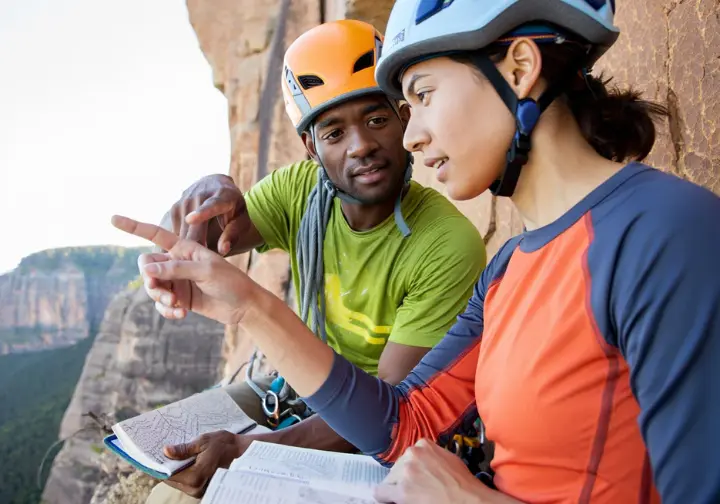
Trad climbing involves inherent risks. Sound judgment, systematic risk assessment, and continuous learning from experience are paramount to climb safely and managing these challenges effectively.
Understanding Objective vs. Subjective Hazards
In climbing, hazards are objective or subjective. Objective hazards are inherent to the environment: rockfall, weather changes, hidden rock weaknesses. They can be anticipated. Subjective hazards are introduced by the climber: skill level, decision-making, equipment use. These are largely controllable.
A key safety aspect is recognizing and assessing both hazard types to minimize overall risk. This includes knowing when to retreat if you cannot climb safely. General rock climbing safety information often covers these distinctions. For example, alpine climbing involves navigating harsh, fluctuating conditions safely, which highlights objective hazard management.
The Role of Judgment and Decision-Making
Good judgment is paramount in trad climbing, arguably more so than physical strength. It’s a continuous process of evaluating risks, assessing abilities, and making sound decisions, often under pressure. This “trad head” develops with experience. Decisions range from route selection to assessing placements.
Factors influencing judgment include experience, training, mental state, and environmental conditions. Cultivating self-awareness and a humble approach are key. Even at moderate climbing grades, like those discussed in trad climbing tips for leading Severe, good judgment is essential. This extends to building trust in equipment and partners.
Learning from Incidents and Near Misses
The climbing community emphasizes learning from accidents and near misses. Organizations like the American Alpine Club (“Accidents in North American Climbing”) and the BMC analyze incident data. Studying these reports, such as BMC incident reporting analysis, provides valuable lessons on belaying errors, inadequate protection, or judgment errors.
Sharing personal experiences of near misses constructively contributes to collective learning. A culture of openness is vital for enhancing safety in trad climbing. This learning process can also inform how to manage minor issues and prevent further injury.
The Journey into Trad: Learning, Progression, and Styles
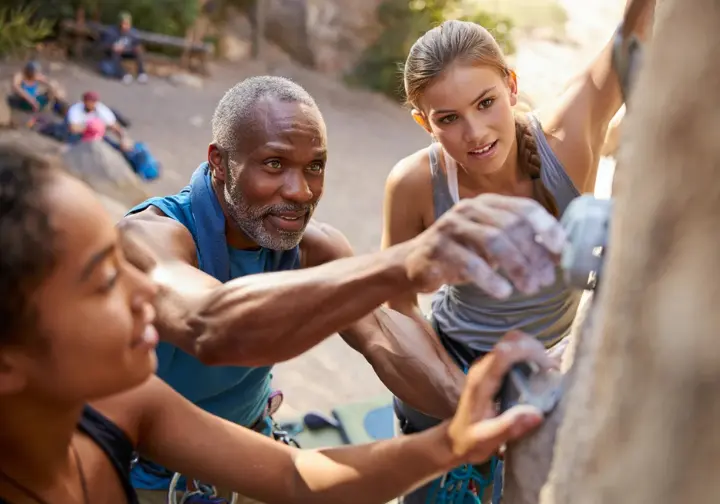
Embarking on the trad climbing path is a rewarding journey. This section offers guidance on how to learn, typical progression pathway, the importance of mentorship, and an overview of different trad climbing styles, including some information a guide might provide.
Finding Mentors and Quality Trad Courses
Learning trad climbing safely requires guidance. A knowledgeable, patient mentor teaching best practices is invaluable. Look for mentors emphasizing safety and understanding trad systems. Professional instruction from certified climbing guides, such as an AMGA-certified guide, or reputable climbing schools offering guided climbing is another excellent way. The guidance for new outdoor climbers can be a great starting point.
Qualified guides provide structured learning and a safe environment for practicing skills. Consider certifications (AMGA, MIA), experience, and curriculum. Investing in quality instruction, perhaps through certified climbing instructor programs, is an investment in safety and development for any trad climber.
Transitioning from Sport or Gym to Trad Climbing
Many climbers transition to trad after sport climbing or gym climbing experience. While climbing movement skills are transferable, trad climbing introduces new complexities: gear placement, anchor building, risk management. Common challenges include developing the “trad head,” learning efficient protection placement, and understanding multi-pitch rope management before attempting a traditional climb. This how to start trad climbing guide can be helpful.
Start slowly: mock lead (placing gear on toprope), follow experienced trad leaders, and practice skills in low-consequence environments. Using top rope climbing as a foundation can ease this transition.
Understanding Trad Grades and Their Nuances
Trad climbing grades can be more complex than sport climbing grades. Systems like YDS (e.g., 5.9) often give only a technical rating, but actual difficulty of a trad route varies based on protection quality, sustained difficulty, and exposure. The British system (e.g., HVS 5a) uses adjectival and technical grades for a holistic view. These grading scales attempt to quantify a multifaceted challenge.
A trad grade often implies more than physical difficulty; it reflects the overall experience. Starting below one’s sport climbing grade is advisable. Understanding these, including the UIAA rock climbing grades, is important. Some areas are known for understanding notoriously sandbagged grades, adding another layer of complexity for the aspiring rock climber.
Different Styles of Trad Ascents (Onsight, Redpoint, Headpoint)
Trad climbs can be approached in various styles. An “onsight” is considered the purest style of free climbing, where a climber leads a route from bottom to top on their first ascent without falling or weighting the rope, and with no prior information beyond the guidebook. A “flash” is similar but with some prior info (beta). A “redpoint,” sometimes associated with the grünpunkt movement in Europe, involves a successful free ascent after previous practice. Many resources explain climbing styles redpoint onsight headpoint in detail, covering everything from a first free ascent to a third ascent.
“Headpointing” is often for very difficult trad routes, where the climber extensively practices the route on a toprope, perhaps after reading about it on a site like planetmountain.com, rehearsing moves and trad gear placements before attempting a lead. Understanding these distinctions is important for appreciating climbing achievements, including those involving solo climbing or even free solo climbing by elite athletes. Famous routes often see stylistic advancements on Freerider over time.
Iconic Trad Destinations: Where the Adventure Began
Certain climbing areas are synonymous with trad climbing, holding historical significance. Yosemite National Park is a birthplace, with El Capitan and Half Dome. Other North American spots include The Gunks (NY), Indian Creek (UT), famous for its parallel-sided sandstone crack climbing and challenging Utah sandstone climbs; and Squamish (BC). These areas often have specific NPS rock climbing regulations.
Internationally, the Peak District (UK), Dolomites (Italy), and Mount Arapiles (Australia) boast rich trad climbing traditions. Exploring these climbing areas provides a connection to climbing history. Each climb offers a unique experience on these traditional climbs and a taste of diverse rock types and styles, from a simple rock climb to demanding traditional climbing routes.
Conclusion: The Enduring Appeal of Traditional Climbing
Trad climbing is profoundly more than placing protection; it’s an engagement with rock, risk, and self, offering a unique path to adventure and personal growth. The core elements of self-reliance, problem-solving, mental fortitude, and ethical commitment define the trad experience and contribute to its lasting allure.
Embracing this journey opens a world of exploration on magnificent rock faces, fostering a deep connection with nature and the climbing community. We encourage you to continue prioritizing learning, practice diligently with experienced mentors, and always uphold the ethics of clean climbing and environmental stewardship. This will help preserve these invaluable experiences for future generations. Our blog aims to be a comprehensive resource and inspire rock trad exploration; further explore our articles on specific gear, techniques, and destinations to deepen your understanding.
Frequently Asked Questions about Understanding Trad Climbing
Is trad climbing more dangerous than sport climbing? >
What are the first pieces of gear I should buy for trad climbing? >
How long does it take to become proficient at trad climbing? >
Can I practice trad climbing skills in a gym? >
We are a participant in the Amazon Services LLC Associates Program, an affiliate advertising program designed to provide a means for sites to earn advertising fees by advertising and linking to Amazon.com. As an Amazon Associate I earn from qualifying purchases. We also participate in other affiliate programs. The information provided on this website is provided for entertainment purposes only. We make no representations or warranties of any kind, expressed or implied, about the completeness, accuracy, adequacy, legality, usefulness, reliability, suitability, or availability of the information, or about anything else. Any reliance you place on the information is therefore strictly at your own risk. Additional terms are found in the terms of service.


